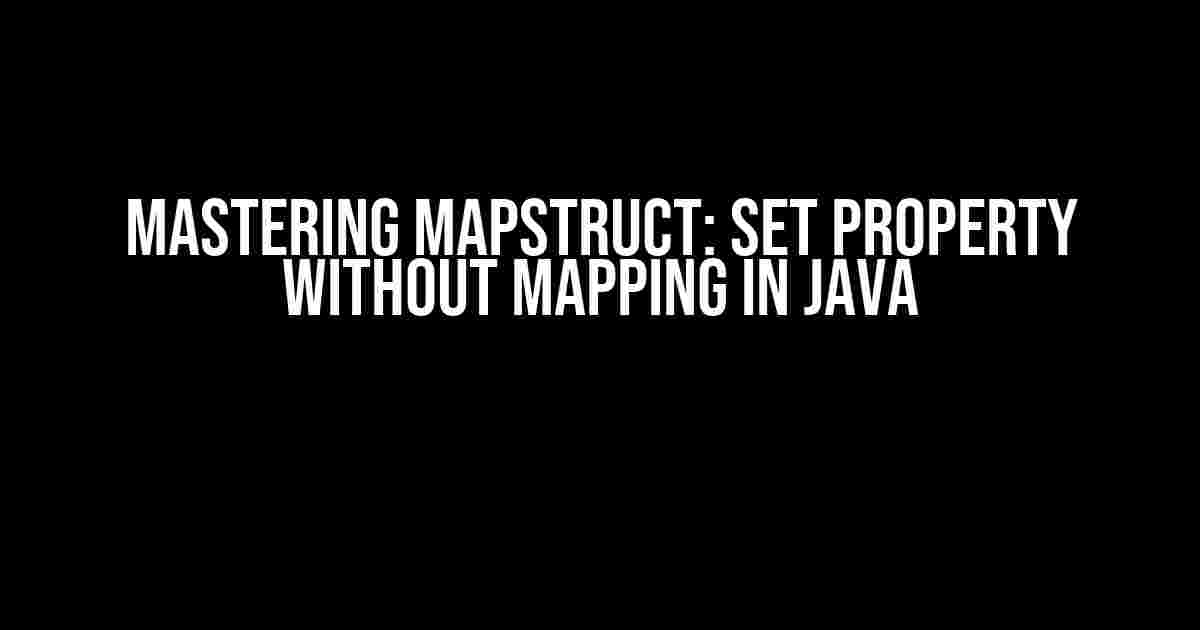Hey there, fellow developers! Are you stuck with Mapstruct, trying to figure out how to set a property without mapping in Java? Well, you’re in luck because today we’re going to dive deep into this topic and explore the best practices to achieve this. By the end of this article, you’ll be a Mapstruct master, effortlessly setting properties without mapping like a pro!
What is Mapstruct?
Before we dive into the main topic, let’s quickly cover the basics. Mapstruct is a Java-based convention-driven object-object mapper that helps you map Java objects from one type to another. It’s a powerful tool that simplifies the process of transforming data between different objects, making your code more efficient and readable.
The Problem: Setting Properties without Mapping
Now, let’s assume you have a source object and a target object, and you want to map some properties from the source to the target. But, what if you need to set a property on the target object without mapping it from the source? This is where things can get a bit tricky. You might be thinking, “Why can’t I just set the property manually?” Well, you can, but that would defeat the purpose of using Mapstruct in the first place.
Instead, we’ll explore two approaches to set properties without mapping in Mapstruct: using the `@Mapping` annotation and leveraging the `Mapper` interface.
Approach 1: Using the `@Mapping` Annotation
The `@Mapping` annotation is a powerful feature in Mapstruct that allows you to define custom mappings between source and target properties. But, did you know that you can also use it to set a property on the target object without mapping it from the source?
@Mapper
public interface MyMapper {
@Mapping(target = "propertyWithoutMapping", ignore = true)
TargetObject map(SourceObject source);
@BeanMapping(ignoringByDefault = true)
@Mapping(target = "propertyWithoutMapping", ignore = false)
void mapToTarget(SourceObject source, @MappingTarget TargetObject target);
}
In the above code snippet, we’re using the `@Mapping` annotation to specify that the `propertyWithoutMapping` property on the target object should be set without mapping it from the source. The `ignore = true` attribute tells Mapstruct to ignore the property during the mapping process.
However, in the second method, `mapToTarget`, we’re using the `ignoringByDefault = true` attribute on the `@BeanMapping` annotation to ignore all properties by default. Then, we’re using the `@Mapping` annotation to set the `propertyWithoutMapping` property explicitly, overriding the default behavior.
Approach 2: Leveraging the `Mapper` Interface
The second approach involves using the `Mapper` interface to set properties without mapping. This approach is more flexible and allows you to customize the mapping process to your heart’s content.
@Mapper
public interface MyMapper {
TargetObject map(SourceObject source);
default void afterMap(SourceObject source, @MappingTarget TargetObject target) {
target.setPropertyWithoutMapping("custom value");
}
}
In this example, we’re using the `afterMap` method, which is part of the `Mapper` interface, to set the `propertyWithoutMapping` property on the target object after the mapping process is complete. This approach gives you more control over the mapping process and allows you to perform additional operations or set properties that aren’t mapped from the source object.
Best Practices
Now that we’ve covered the two approaches to set properties without mapping in Mapstruct, let’s discuss some best practices to keep in mind:
- Use the `@Mapping` annotation sparingly: While the `@Mapping` annotation is powerful, it can make your code harder to read and maintain if overused. Use it only when necessary, and prefer the `Mapper` interface approach for more complex mappings.
- Document your custom mappings: When using custom mappings, make sure to document them clearly in your code using JavaDoc or comments. This will help other developers understand the mapping process and reduce errors.
- Test your mappings thoroughly: Always test your mappings thoroughly to ensure they’re working as expected. Use unit tests and integration tests to validate your mappings and catch any errors early.
Conclusion
And there you have it, folks! With these two approaches and best practices, you’re now equipped to set properties without mapping in Mapstruct like a pro. Remember to use the `@Mapping` annotation sparingly and leverage the `Mapper` interface for more complex mappings.
By mastering Mapstruct, you’ll be able to write more efficient, readable, and maintainable code that simplifies the process of transforming data between different objects.
| Approach | Description |
|---|---|
| Using the `@Mapping` annotation | Use the `@Mapping` annotation to set a property on the target object without mapping it from the source. |
| Leveraging the `Mapper` interface | Use the `Mapper` interface to set properties without mapping, providing more control over the mapping process. |
Happy coding, and don’t forget to share your Mapstruct experiences and tips in the comments below!
Stay tuned for more articles on Mapstruct and Java development. If you have any suggestions or topics you’d like us to cover, please let us know in the comments!
Frequently Asked Question
Get your doubts cleared about setting properties without mapping in Mapper Java Mapstruct!
Can I set a property without mapping it in Mapstruct?
Yes, you can! Mapstruct provides an `@Mapping` annotation with an `ignore` attribute that allows you to set a property without mapping it. For example, `@Mapping(target = “propertyToSet”, ignore = true)`.
How do I set a default value for a property without mapping it in Mapstruct?
You can use the `expression` attribute in the `@Mapping` annotation to set a default value for a property. For example, `@Mapping(target = “propertyToSet”, expression = “java(‘default value’)”)`. This will set the property to ‘default value’ if no mapping is provided.
Can I use a setter method to set a property without mapping it in Mapstruct?
Yes, you can! Mapstruct allows you to use a setter method to set a property without mapping it. You can use the `@Mapping` annotation with the `uses` attribute to specify the setter method. For example, `@Mapping(target = “propertyToSet”, uses = “setPropertyName”)`.
Is it possible to set a property without mapping it in Mapstruct using a Java-based mapper?
Yes, it is! In a Java-based mapper, you can use the `@AfterMapping` annotation to set a property without mapping it. This method will be called after the mapping is done, and you can set the property manually.
What happens if I try to set a property without mapping it in Mapstruct and it’s not allowed?
If you try to set a property without mapping it in Mapstruct and it’s not allowed, you’ll get a compilation error. Mapstruct will prevent you from setting a property that’s not mapped, ensuring that your code is correct and safe. So, make sure to follow the rules and use the correct annotations to set properties without mapping them!




